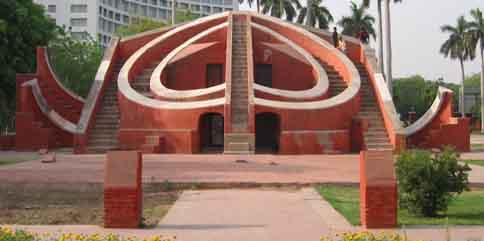Jantar Mantar Delhi

Information on Jantar Mantar (New Delhi) - History & Architecture
The distinguished monument Jantar Mantar is situated in New Delhi. It comprises 13 kinds of architectural mechanisms related to astronomy. It is deemed to be among the five different observatories that were constructed in the year 1724 by Sawai Jai Singh II who was the then Maharaja of Jaipur. These observatories were learnt to be built for the quest of scientific comprehension. The Maharaja served the Mughal court as a noble and was known to be quite an ardent astronomer. The monument was constructed for the purpose of marking out or rather comprehending the astronomical occurrences and facts along with determining scientific information from such phenomenon.
Jantar Mantar Architecture
Jantar Mantar or the observatory is considered to be a disguise with regard to modern art form. The construction work of the observatory commenced from the year 1724. The plan of constructing such an observatory was initiated when Maharaja Sawai Jai Singh was assigned the duty of amending the calendar as well as the astronomical tables by the Mughal emperor Muhammad Shah. The fundamental function of Jantar Mantar was to bring together various astronomical tables and then to forecast the times along with the movements in relation to the planets, sun and the moon. Few of the stated functions in the recent times would be categorized as astronomy. The observatory houses three kinds of tools and they are the Jayaprakash, the Misra Yantra and the Samrat Yantra. The colloquial name 'Jantar Mantar' was derived from the actual terms 'yantar' and 'mantra'.
Jantar Mantar History
The above mentioned form of tools had an immense historical significance attached to them. The Jayaprakash includes hemispheres that were vacant and markings were made on their respective curved in surfaces. Wires were long-drawn-out in a cross wise manner amid the points present on the rim. This instrument aided the observer to bring into line the position of a particular star. The Misra Yantra was a planned tool which focused on ascertaining the longest as well shortest days in a year. It also aided in determining the precise time of noon across several other locations and even cites irrespective of their own distance from the city of Delhi. This particular yantra was considered to be the sole construction in the entire observatory which was not invented by the Maharaja. The Samrat Yantra is also referred as the Supreme Instrument which in reality is a colossal triangle which is principally a sundial of equal hour. This yantra stands tall with a height of 70 feet, has a width of 10 feet and has a base length of 114 feet. It comprises a hypotenuse which has a length of 128 feet and is supposed to be corresponding to the axis of the Earth. The hypotenuse indicates and faces in the direction of the North Pole. A quadrant is placed on both of the sides of each triangle along with graduations that help in specifying the minutes, seconds and hours. Although, sundials subsisted at the time of construction of the yantra, but this particular Samrat Yantra was unlike as it converted the essential sundial to an accurate tool for the reason of gauging declination along with various other correlated directions in relation to diverse heavenly bodies.
Jantar Mantar Tourism Significance
Jantar Mantar is one of the most visited and sought after destination of Delhi. Visitors come from all over the globe just to catch a glance of the astronomic wonder that India had created in such an early period. Millions of visitors flock in Jantar Mantar to witness the eagerness for scientific facts that were present in the Indians from quite an early age.
- Andaman Nicobar Monuments
- Andhra Pradesh Monuments
- Assam Monuments
- Bihar Monuments
- Chhattisgarh Monuments
- New Delhi Monuments
- Goa Monuments
- Gujarat Monuments
- Haryana Monuments
- Himachal Pradesh Monuments
- Jammu and Kashmir Monuments
- Karnataka Monuments
- Kerala Monuments
- Madhya Pradesh Monuments
- Maharashtra Monuments
- Odisha Monuments
- Punjab Monuments
- Rajasthan Monuments
- Tamil Nadu Monuments
- Telangana Monuments
- Uttar Pradesh Monuments
- West Bengal Monuments